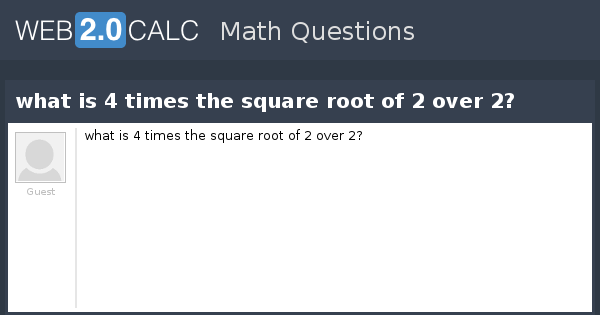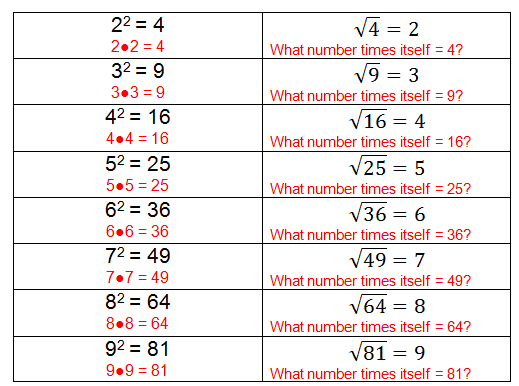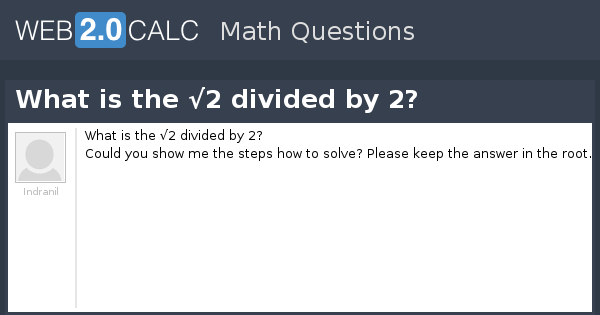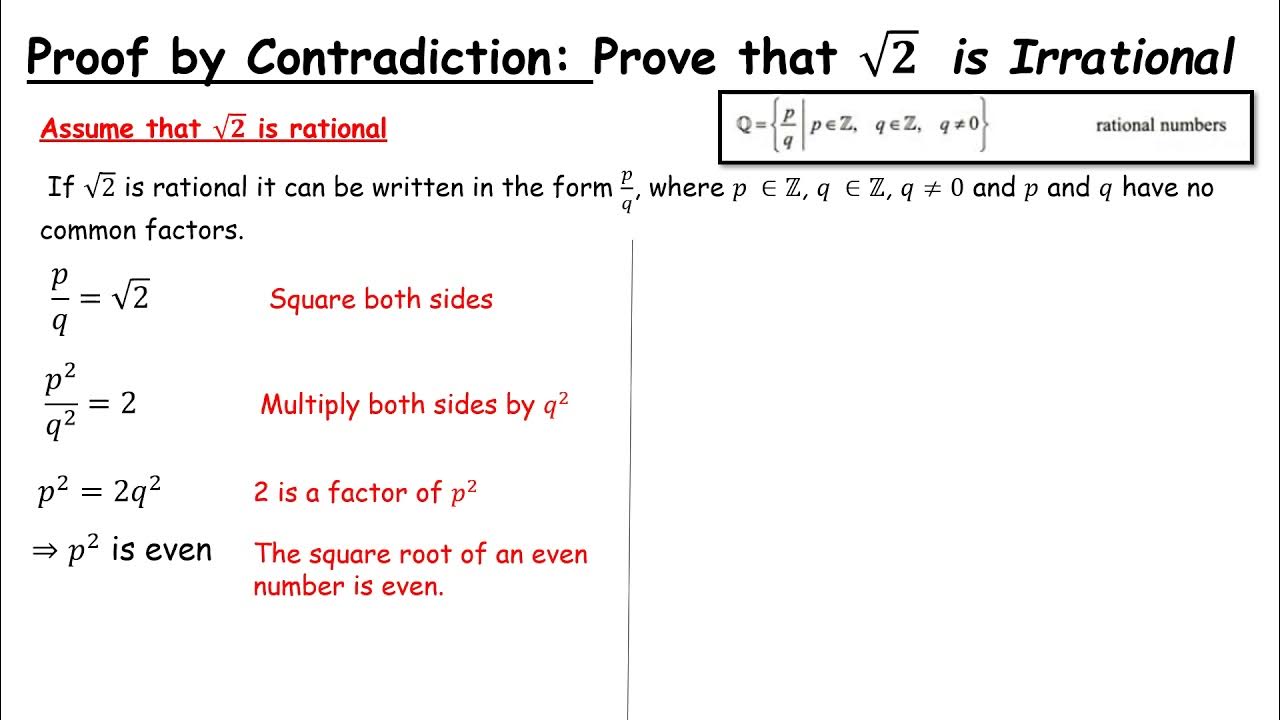Topic square root of 2 as a fraction: The square root of 2 as a fraction is a fascinating topic in mathematics. Despite its apparent simplicity, it reveals profound insights into the nature of numbers and irrationality. Join us as we delve into the history, proofs, and applications of this intriguing mathematical concept.
Table of Content
- Square Root of 2 as a Fraction
- Introduction to Square Root of 2
- Understanding Irrational Numbers
- The Mathematical Definition of Square Root of 2
- Historical Context and Discovery
- Proof of Irrationality
- Square Root of 2 in Decimal Form
- Common Misconceptions
- Approximations and Uses in Mathematics
- Applications in Geometry
- Implications in Algebra
- Role in Trigonometry
- Square Root of 2 in Engineering
- Influence on Modern Mathematics
- YOUTUBE: Video này hướng dẫn cách đơn giản hóa phân số dưới dấu căn, một mẹo hữu ích cho các bài toán.
Square Root of 2 as a Fraction
The square root of 2, often denoted as , is an irrational number. This means it cannot be expressed exactly as a fraction of two integers. The decimal representation of is approximately 1.4142135623730951 and continues infinitely without repeating.
Historical Context
The irrationality of was first proven by the ancient Greeks. The proof, often attributed to Pythagoras or one of his followers, shows that assuming could be expressed as a fraction leads to a contradiction.
Proof by Contradiction
To understand why is irrational, consider the following proof by contradiction:
- Assume can be expressed as a fraction where and are integers with no common factors (in simplest form).
- Then, can be written as , so .
- Squaring both sides gives , so .
- This implies that is even, meaning must be even (because the square of an odd number is odd).
- Let for some integer . Substituting this in gives , so , implying is even and thus is even.
- This means both and are even, contradicting the initial assumption that they have no common factors.
Since assuming is rational leads to a contradiction, it must be irrational.
Conclusion
The square root of 2 cannot be expressed as a fraction because it is an irrational number. This mathematical property underscores the fascinating complexity of numbers and their properties.

READ MORE:
Introduction to Square Root of 2
The square root of 2, represented as , is a significant number in mathematics known for its unique properties and historical importance. It is the positive number that, when multiplied by itself, equals 2.
Here is an overview of key aspects related to the square root of 2:
- Mathematical Definition
- Historical Context and Discovery
- Proof of Irrationality
- Decimal Representation
- Applications in Various Fields
The square root of 2 is best known for its role in proving the existence of irrational numbers, which are numbers that cannot be expressed as a simple fraction of two integers. This discovery was a groundbreaking moment in the history of mathematics, challenging previously held notions about numbers and their properties.
To understand why cannot be represented as a fraction, consider the following points:
- If could be expressed as a fraction, it would be in the form where and are integers with no common factors.
- Squaring both sides of the equation = leads to .
- This implies , indicating that is even.
- If is even, let . Substituting in, we get , showing is even, hence is even.
- This leads to both and being even, contradicting the assumption of having no common factors.
Thus, the square root of 2 is an irrational number, a concept that has profound implications in various mathematical and real-world applications.
Understanding Irrational Numbers
Irrational numbers are real numbers that cannot be expressed as a simple fraction of two integers. Unlike rational numbers, which can be written as the quotient of two integers , where and are integers and is not zero, irrational numbers cannot be exactly represented in this way.
Here are some key characteristics of irrational numbers:
- Non-repeating, non-terminating decimal expansions
- Cannot be written as the ratio of two integers
- Exist on the real number line but cannot be pinpointed as exact fractions
The concept of irrational numbers dates back to ancient Greece. The discovery that not all numbers can be represented as fractions was a major development in mathematics. The most famous example of an irrational number is the square root of 2, denoted as .
To understand why is irrational, consider the following proof by contradiction:
- Assume can be written as a fraction where and are coprime integers.
- Then, , which implies .
- This means is even, so must be even. Let for some integer .
- Substitute in the equation: , which simplifies to .
- Divide both sides by 2: , which implies is even, so must be even.
- Since both and are even, they share a common factor of 2, contradicting the assumption that and are coprime.
Thus, the assumption is false, proving that is irrational. This example illustrates the fascinating complexity and beauty of irrational numbers, enriching our understanding of the mathematical world.
The Mathematical Definition of Square Root of 2
The square root of 2, denoted as , is defined as the positive real number that, when multiplied by itself, equals 2. In other words:
where .
To understand the properties of , consider the following points:
- Real Number: The square root of 2 is a real number, meaning it exists on the number line and can be represented as a decimal.
- Irrationality: The square root of 2 cannot be expressed as a fraction of two integers. Its decimal form is non-repeating and non-terminating.
- Algebraic Property: In algebraic terms, such that has no exact rational solution.
Let's delve into how we can approximate the square root of 2:
- Start with an initial guess, say .
- Use the formula for better approximation: where is the previous approximation.
- Apply the formula iteratively to get closer to the actual value. For instance, starting with , the next approximation is .
- Continue this process to achieve more precise values.
This method of approximation shows the iterative nature of calculating irrational numbers and highlights the complexity of the square root of 2.
In summary, the mathematical definition of the square root of 2 involves understanding its real number properties, its irrational nature, and the algebraic principles that define it. The square root of 2 is a fundamental concept that reveals the intricacies and beauty of mathematical exploration.
Historical Context and Discovery
The discovery of the square root of 2 has a rich historical context that dates back to ancient civilizations. It is one of the earliest known instances of an irrational number, challenging the mathematical understanding of the time. Here's a detailed look at the history and discovery of the square root of 2:
- Babylonian Mathematics: Around 1800 BCE, Babylonian mathematicians approximated the square root of 2 using a method similar to the modern-day iterative method. They recorded their findings on clay tablets, demonstrating a surprisingly accurate value.
- Ancient Indian Mathematics: Indian mathematicians also explored the concept of the square root of 2. The Sulbasutras, ancient Indian texts on geometry, include approximations of the square root of 2 for constructing altars.
- Pythagorean Theorem: The Greek mathematician Pythagoras (circa 570-495 BCE) and his followers discovered the irrationality of the square root of 2 while studying the Pythagorean Theorem. They realized that the diagonal of a square with side length 1 is , and that this value could not be expressed as a fraction.
- Hippasus of Metapontum: According to legend, Hippasus, a Pythagorean philosopher, was the first to formally prove the irrationality of the square root of 2. His discovery allegedly caused a great upheaval among the Pythagoreans, as it contradicted their belief that all numbers could be expressed as the ratio of integers.
Here's an outline of the key historical steps in discovering the irrationality of the square root of 2:
- Ancient Babylonian and Indian mathematicians developed early approximations.
- Pythagoreans studied the geometric implications and realized the diagonal of a unit square was .
- Hippasus of Metapontum proved the irrationality of the square root of 2, marking a significant shift in mathematical thought.
The discovery of the square root of 2's irrationality had profound implications for mathematics. It revealed the existence of numbers that could not be expressed as simple fractions, leading to the development of new mathematical concepts and techniques. This discovery also played a crucial role in the evolution of algebra and number theory.
In summary, the historical context and discovery of the square root of 2 highlight the progression of mathematical understanding across different cultures and eras. It underscores the importance of challenging established beliefs and the continuous pursuit of knowledge in the field of mathematics.
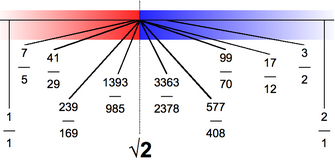
Proof of Irrationality
The square root of 2 is one of the most famous examples of an irrational number. The proof of its irrationality can be demonstrated using a method called proof by contradiction. Here is a detailed step-by-step explanation:
- Assume the Opposite:
Assume that is rational. This means it can be written as a fraction , where and are coprime integers (i.e., they have no common factors other than 1).
- Express the Assumption:
If is rational, then it can be expressed as . Squaring both sides, we get:
This simplifies to:
- Analyze the Equation:
The equation implies that is an even number, since it is equal to 2 times another integer. Therefore, must also be even.
Since is even, we can write for some integer . Substituting this back into the equation, we get:
which simplifies to:
Dividing both sides by 2, we get:
- Conclusion:
This implies that is also even, and therefore must be even. However, this contradicts our initial assumption that and are coprime (since both being even means they have a common factor of 2).
Since our assumption leads to a contradiction, it must be false. Therefore, the square root of 2 cannot be expressed as a fraction of two integers, proving that it is irrational.
This proof by contradiction elegantly shows the irrationality of the square root of 2, highlighting the depth and precision of mathematical logic.
Square Root of 2 in Decimal Form
The square root of 2, often denoted as , is an irrational number, which means its decimal representation is non-repeating and non-terminating. The decimal approximation of the square root of 2 begins with:
To better understand this decimal form, we can look at a few key points:
- Non-Repeating Nature: The digits after the decimal point never form a repeating pattern. This characteristic is a hallmark of irrational numbers.
- Non-Terminating Sequence: The decimal form of the square root of 2 continues infinitely without terminating, which means it cannot be exactly represented as a finite decimal or fraction.
Here's a step-by-step method to approximate the square root of 2 using a process called the Babylonian method or Heron's method:
- Start with an initial guess, .
- Use the iterative formula:
- Apply the formula to refine the approximation:
- First iteration:
- Second iteration:
- Third iteration:
- Continue iterating until the desired level of precision is achieved.
The decimal form of the square root of 2 is used in various fields such as engineering, physics, and computer science. Its accurate approximation is crucial for precise calculations in these disciplines.
In summary, the square root of 2 in decimal form is an infinite, non-repeating sequence that can be approximated through iterative methods. This property exemplifies the nature of irrational numbers and their significance in mathematical computations.
Common Misconceptions
The concept of the square root of 2 often leads to several common misconceptions. Understanding these misconceptions helps in clarifying the true nature of this important mathematical constant.
- Misconception 1: The Square Root of 2 is Rational
One of the most prevalent misconceptions is that the square root of 2 can be expressed as a fraction. However, as proven through the method of contradiction, is an irrational number, meaning it cannot be written as a simple fraction of two integers.
- Misconception 2: Approximate Fractions are Exact
Some people believe that approximate fractional representations, like or , are exact values of the square root of 2. While these fractions are close approximations, they are not exact and do not capture the infinite, non-repeating nature of the decimal expansion of .
- Misconception 3: The Decimal Expansion is Terminating or Repeating
Another common misconception is that the decimal expansion of the square root of 2 either terminates or eventually repeats. In reality, the decimal expansion of is infinite and non-repeating, which is a key characteristic of irrational numbers.
- Misconception 4: Irrational Numbers are Rare
There is a misconception that irrational numbers like the square root of 2 are rare. In fact, irrational numbers are quite common and make up most of the real numbers. They are crucial in various fields of science and mathematics, providing necessary precision in calculations.
- Misconception 5: Only Advanced Mathematics Deals with Irrational Numbers
Some believe that irrational numbers are only relevant in advanced mathematics. However, concepts involving irrational numbers, including the square root of 2, appear in basic geometry, algebra, and even everyday measurements, making them fundamental to a wide range of mathematical studies.
By addressing these misconceptions, we can gain a clearer understanding of the properties and significance of the square root of 2. Recognizing that is an irrational number with an infinite, non-repeating decimal expansion is crucial for accurate mathematical comprehension and application.
Approximations and Uses in Mathematics
The square root of 2, denoted as \(\sqrt{2}\), is an irrational number, meaning it cannot be expressed exactly as a fraction of two integers. However, it can be approximated to a high degree of accuracy using various methods. Here we explore some common approximations and their uses in mathematics.
Decimal Approximations
The square root of 2 can be approximated in decimal form. Some common decimal approximations include:
- 1.4
- 1.41
- 1.414
- 1.4142
- 1.41421
The more decimal places we use, the more accurate our approximation becomes. The value \(\sqrt{2}\) is approximately 1.414213562, but it continues infinitely without repeating.
Fractional Approximations
Although \(\sqrt{2}\) is irrational, we can still use fractions to approximate its value. Some common fractional approximations include:
- \(\frac{3}{2}\) = 1.5
- \(\frac{7}{5}\) = 1.4
- \(\frac{17}{12}\) = 1.4167
- \(\frac{577}{408}\) ≈ 1.4142157
These fractions provide increasingly accurate approximations of \(\sqrt{2}\).
Continued Fractions
Another method to approximate \(\sqrt{2}\) is using continued fractions. The continued fraction representation of \(\sqrt{2}\) is:
\[
\sqrt{2} = 1 + \frac{1}{2 + \frac{1}{2 + \frac{1}{2 + \frac{1}{2 + \cdots}}}}
\]
This infinite series converges to the exact value of \(\sqrt{2}\) and can be truncated at any point to provide an approximation.
Applications in Geometry
The square root of 2 is significant in geometry, particularly in the context of right triangles. The length of the diagonal of a square with side length 1 is \(\sqrt{2}\). This relationship is used to derive the Pythagorean theorem for isosceles right triangles, where the legs are equal, and the hypotenuse is \(\sqrt{2}\) times the length of a leg.
Applications in Trigonometry
In trigonometry, \(\sqrt{2}\) appears in the simplification of expressions involving \(\sin\) and \(\cos\) of 45° (or \(\pi/4\)) angles:
\[
\sin\left(\frac{\pi}{4}\right) = \cos\left(\frac{\pi}{4}\right) = \frac{\sqrt{2}}{2}
\]
These values are fundamental in solving problems involving 45°-45°-90° triangles.
Engineering and Other Uses
In engineering, \(\sqrt{2}\) is used in calculations involving power and signal processing. For instance, in AC circuit analysis, the root mean square (RMS) value of a sine wave is \(\frac{V_{peak}}{\sqrt{2}}\), where \(V_{peak}\) is the peak voltage. This is crucial in designing and analyzing electrical systems.
Overall, \(\sqrt{2}\) is a versatile number with broad applications in various fields of mathematics, engineering, and science. Despite its irrationality, the approximations of \(\sqrt{2}\) allow us to utilize its properties effectively in practical and theoretical problems.

Applications in Geometry
The square root of 2, denoted as \(\sqrt{2}\), plays a crucial role in various geometric contexts. Here, we explore some of the most important applications and how this irrational number is used in geometric calculations and proofs.
Diagonal of a Square
One of the most well-known applications of \(\sqrt{2}\) in geometry is in the calculation of the diagonal of a square. For a square with side length \(a\), the length of the diagonal \(d\) can be determined using the Pythagorean theorem:
\[
d = \sqrt{a^2 + a^2} = \sqrt{2a^2} = a\sqrt{2}
\]
This relationship shows that the diagonal of a square is \(\sqrt{2}\) times the length of its side.
45°-45°-90° Triangles
In a 45°-45°-90° triangle, which is an isosceles right triangle, the legs are of equal length. If each leg has a length of \(a\), the hypotenuse \(h\) is given by:
\[
h = a\sqrt{2}
\]
This type of triangle frequently appears in problems involving symmetry and tiling patterns.
Relationship to Regular Polygons
The square root of 2 also appears in the context of regular polygons, particularly those inscribed in circles. For example, in a regular octagon (an eight-sided polygon), the ratio of the side length to the radius of the circumscribed circle involves \(\sqrt{2}\). If the side length of the octagon is \(s\), the radius \(r\) can be expressed as:
\[
r = \frac{s}{2 \sin(\pi/8)} = \frac{s}{2 \sin(22.5^\circ)} = \frac{s}{2 \cdot 0.3827} \approx \frac{s}{0.7654}
\]
Area Calculations
The square root of 2 is also useful in area calculations involving squares and circles. For instance, if you have a square with side length 1, the area of the square is 1. The circle that can be inscribed in this square has a radius of \(\frac{1}{2}\sqrt{2}\), and its area \(A\) can be calculated as:
\[
A = \pi \left(\frac{\sqrt{2}}{2}\right)^2 = \pi \left(\frac{2}{4}\right) = \frac{\pi}{2}
\]
This relationship highlights the geometric interplay between squares and circles.
Tiling and Tessellation
\(\sqrt{2}\) is significant in the study of tiling and tessellation patterns, particularly in the context of Penrose tiling, which uses two shapes to create a non-repeating pattern. The ratio of the lengths of the shapes involved often relates to \(\sqrt{2}\), contributing to the aperiodic nature of the tiling.
Overall, the square root of 2 is fundamental in various geometric principles and constructions, making it an essential number in both theoretical and applied geometry.
Implications in Algebra
The square root of 2, represented as \(\sqrt{2}\), has significant implications in algebra, particularly in the context of irrational numbers, polynomial equations, and algebraic structures. Here we explore some key aspects where \(\sqrt{2}\) plays an important role.
Understanding Irrational Numbers
The discovery that \(\sqrt{2}\) is irrational was pivotal in the history of mathematics. This means that \(\sqrt{2}\) cannot be expressed as a ratio of two integers. The proof of the irrationality of \(\sqrt{2}\) is a classic example in algebra and is typically presented as follows:
Assume \(\sqrt{2}\) is rational, meaning it can be written as \(\frac{a}{b}\) where \(a\) and \(b\) are coprime integers. Then:
\[
\sqrt{2} = \frac{a}{b} \implies 2 = \frac{a^2}{b^2} \implies 2b^2 = a^2
\]
This implies \(a^2\) is even, so \(a\) must be even. Let \(a = 2k\), then:
\[
2b^2 = (2k)^2 \implies 2b^2 = 4k^2 \implies b^2 = 2k^2
\]
This implies \(b^2\) is even, so \(b\) must also be even. This contradicts the assumption that \(a\) and \(b\) are coprime, proving that \(\sqrt{2}\) is irrational.
Solving Quadratic Equations
The quadratic equation is a fundamental part of algebra, and \(\sqrt{2}\) often appears in solutions. Consider the equation:
\[
x^2 - 2 = 0
\]
Solving for \(x\), we get:
\[
x = \pm\sqrt{2}
\]
This demonstrates that \(\sqrt{2}\) is a solution to a simple quadratic equation, highlighting its importance in algebraic equations.
Conjugates and Polynomial Roots
In algebra, conjugates play a crucial role. For an irrational number like \(\sqrt{2}\), its conjugate is \(-\sqrt{2}\). The conjugate pairs often appear in the context of polynomial equations with real coefficients. For example, if \(x = \sqrt{2}\) is a root of a polynomial, then \(x = -\sqrt{2}\) is also a root. This ensures that the polynomial has real coefficients.
Consider the polynomial:
\[
(x - \sqrt{2})(x + \sqrt{2}) = x^2 - (\sqrt{2})^2 = x^2 - 2
\]
Here, \(\sqrt{2}\) and \(-\sqrt{2}\) are roots of the polynomial \(x^2 - 2\), showcasing the relationship between irrational roots and their conjugates.
Field Extensions
The concept of field extensions in algebra involves extending a given field to include additional elements. \(\sqrt{2}\) is often used in such extensions. For instance, starting with the field of rational numbers \(\mathbb{Q}\), we can construct the field \(\mathbb{Q}(\sqrt{2})\) which includes all numbers of the form \(a + b\sqrt{2}\) where \(a\) and \(b\) are rational numbers. This field extension is denoted as:
\[
\mathbb{Q}(\sqrt{2}) = \{ a + b\sqrt{2} \mid a, b \in \mathbb{Q} \}
\]
This extension is important in understanding the structure and properties of more complex number systems.
In conclusion, \(\sqrt{2}\) serves as a key example in various algebraic contexts, from proving the existence of irrational numbers to solving quadratic equations and exploring field extensions. Its properties and applications make it an essential concept in the study of algebra.
Role in Trigonometry
The square root of 2, represented as \(\sqrt{2}\), plays a fundamental role in trigonometry. It appears in various trigonometric identities, calculations involving angles, and the analysis of trigonometric functions. Here we explore some key aspects of its role in trigonometry.
Special Angles
One of the most significant appearances of \(\sqrt{2}\) in trigonometry is in the values of trigonometric functions for special angles, particularly 45° (or \(\pi/4\) radians). For a 45°-45°-90° triangle, the sides are in the ratio 1:1:\(\sqrt{2}\). Thus, the sine and cosine of 45° are given by:
\[
\sin\left(45^\circ\right) = \cos\left(45^\circ\right) = \frac{1}{\sqrt{2}} = \frac{\sqrt{2}}{2}
\]
This relationship is fundamental in solving problems involving 45° angles and simplifies many trigonometric expressions.
Pythagorean Identity
The square root of 2 is also related to the Pythagorean identity in trigonometry, which states that for any angle \(\theta\):
\[
\sin^2(\theta) + \cos^2(\theta) = 1
\]
For \(\theta = 45^\circ\), we can verify this identity using \(\sin(45^\circ) = \cos(45^\circ) = \frac{\sqrt{2}}{2}\):
\[
\left(\frac{\sqrt{2}}{2}\right)^2 + \left(\frac{\sqrt{2}}{2}\right)^2 = \frac{2}{4} + \frac{2}{4} = 1
\]
This confirms the Pythagorean identity for this special angle.
Trigonometric Function Transformations
The value \(\sqrt{2}\) is essential in understanding transformations of trigonometric functions, especially in amplitude and frequency modifications. For example, consider the function:
\[
f(x) = \sqrt{2} \sin(x)
\]
Here, \(\sqrt{2}\) represents the amplitude of the sine wave, indicating that the maximum value of the function is \(\sqrt{2}\). Such transformations are crucial in signal processing and harmonic analysis.
Inverse Trigonometric Functions
The square root of 2 also appears in the context of inverse trigonometric functions. For instance, consider the inverse sine function. We know:
\[
\sin^{-1}\left(\frac{\sqrt{2}}{2}\right) = 45^\circ \text{ or } \frac{\pi}{4} \text{ radians}
\]
This demonstrates how \(\sqrt{2}\) is used to determine specific angles from trigonometric function values.
Complex Numbers and Euler's Formula
In advanced trigonometry, particularly when dealing with complex numbers, \(\sqrt{2}\) appears in Euler's formula and related expressions. For example, for a complex number in polar form \(re^{i\theta}\) with \(r = \sqrt{2}\) and \(\theta = \frac{\pi}{4}\), we have:
\[
\sqrt{2} e^{i \pi/4} = \sqrt{2} \left(\cos\left(\frac{\pi}{4}\right) + i\sin\left(\frac{\pi}{4}\right)\right) = 1 + i
\]
This relationship is vital in converting between rectangular and polar forms of complex numbers.
Overall, \(\sqrt{2}\) is deeply embedded in trigonometric principles and calculations, playing a crucial role in simplifying expressions, solving equations, and understanding the properties of trigonometric functions.
Square Root of 2 in Engineering
The square root of 2, approximately 1.414, plays a crucial role in various engineering applications due to its mathematical properties. Below are some of the key areas where it is particularly significant:
- Signal Processing: In signal processing, the square root of 2 is used in the normalization of signals. It helps in the transformation of signals from one domain to another, such as from time to frequency domain using the Fast Fourier Transform (FFT). This is crucial for analyzing the frequency components of signals.
- Electrical Engineering: The root mean square (RMS) value of an alternating current (AC) signal is derived using the square root of 2. For a sinusoidal waveform, the RMS value is the peak value divided by the square root of 2, which is essential for calculating power in AC circuits.
- Mechanical Engineering: In mechanics, the square root of 2 appears in calculations involving diagonal distances. For instance, in structural engineering, the diagonal of a square with side length \(a\) is \(a\sqrt{2}\), which is important for determining stresses and strains in materials.
- Robotics: The square root of 2 is used in algorithms for pathfinding and motion planning in robotics. For example, in a grid-based pathfinding algorithm like A*, the movement cost between diagonal grid cells is often approximated as \( \sqrt{2} \) times the cost of moving horizontally or vertically.
- Control Systems: In control systems, especially those dealing with vibrations and oscillations, the damping ratio is often related to the square root of 2. Critical damping occurs when the damping ratio equals 1, and this involves calculations with the square root of 2 to ensure the system returns to equilibrium without oscillating.
Overall, the square root of 2 is an essential constant in engineering, facilitating precise calculations and efficient designs in multiple domains. Its appearance in mathematical formulas and algorithms underscores its importance in both theoretical and practical aspects of engineering.

Influence on Modern Mathematics
The square root of 2 has had a profound influence on modern mathematics, particularly in the fields of number theory, algebra, and geometry. Its discovery marked a significant milestone, leading to the realization that not all numbers are rational, thus introducing the concept of irrational numbers.
Here are several key ways in which the square root of 2 has influenced modern mathematics:
- Irrational Numbers: The square root of 2 was the first number proven to be irrational. This discovery challenged the ancient Greek belief that all numbers could be expressed as the ratio of integers. The existence of irrational numbers expanded the number system and led to a deeper understanding of numerical properties.
- Algebraic Structures: The irrationality of the square root of 2 plays a crucial role in algebra, particularly in the study of fields and polynomial equations. It exemplifies the roots of non-linear polynomials that are not rational, influencing the development of algebraic theories and structures.
- Real Number Line: The inclusion of irrational numbers like the square root of 2 ensures the completeness of the real number line. This completeness is essential for calculus and real analysis, providing a foundation for limits, continuity, and integrals.
- Continued Fractions: The representation of the square root of 2 as a continued fraction is significant in number theory. Its continued fraction is periodic, given by:
\[ \sqrt{2} = 1 + \frac{1}{2 + \frac{1}{2 + \frac{1}{2 + \ldots}}} \]This representation helps in the study of Diophantine approximations and the convergence properties of sequences.
- Geometry and Trigonometry: The square root of 2 is fundamental in geometry, especially in relation to right triangles. It appears as the length of the hypotenuse in an isosceles right triangle with legs of length 1, demonstrating the Pythagorean theorem:
\[ \sqrt{2} = \sqrt{1^2 + 1^2} \]This geometric relationship is vital in trigonometry, where the square root of 2 frequently appears in calculations involving sine, cosine, and tangent functions.
The influence of the square root of 2 extends beyond theoretical mathematics to practical applications in various fields, including engineering, physics, and computer science. Its properties are integral to the development of algorithms, numerical methods, and the understanding of complex systems.
Video này hướng dẫn cách đơn giản hóa phân số dưới dấu căn, một mẹo hữu ích cho các bài toán.
Đơn Giản Hóa Phân Số Dưới Dấu Căn - Mẹo Toán Học Hợp Pháp
READ MORE:
Video này sẽ giải thích và chứng minh tại sao căn bậc hai của 2 không thể là một phân số.
Căn Bậc Hai của 2
